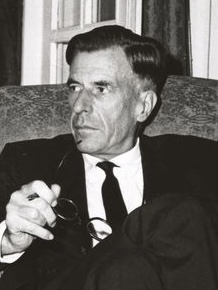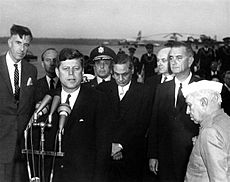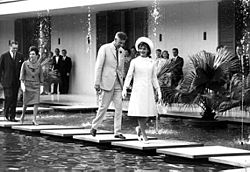John Kenneth Galbraith facts for kids
Quick facts for kids
John Kenneth Galbraith
|
|
|---|---|

Galbraith in 1962
|
|
| 7th United States Ambassador to India | |
| In office April 18, 1961 – July 12, 1963 |
|
| President | John F. Kennedy |
| Preceded by | Ellsworth Bunker |
| Succeeded by | Chester Bowles |
| Personal details | |
| Born | October 15, 1908 Iona Station, Ontario, Canada |
| Died | April 29, 2006 (aged 97) Cambridge, Massachusetts, U.S. |
| Spouse |
Catherine Merriam Atwater
(m. 1937) |
| Children | 4, including Peter and James |
| Academic career | |
| Institution | |
| Alma mater | Ontario Agricultural College (BSAg) University of California, Berkeley (MA, PhD) |
| Influences | Thorstein Veblen, Adam Smith, Karl Marx, John Maynard Keynes, Michał Kalecki, Gardiner Means, Adolf A. Berle |
| Contributions | Countervailing power, technostructure, conventional wisdom |
| Awards | Lomonosov Gold Medal (1993) Officer of the Order of Canada (1997) |
John Kenneth Galbraith (October 15, 1908 – April 29, 2006) was a famous Canadian-American economist, diplomat, and public speaker. He was also known as Ken Galbraith. His books about how economies work were very popular from the 1950s to the 2000s. He was a professor of economics at Harvard University for 50 years.
Galbraith wrote many books, including some novels, and over a thousand articles. His most famous economic books are a group of three: American Capitalism (1952), The Affluent Society (1958), and The New Industrial State (1967). Some economists, like Milton Friedman and Paul Krugman, had different ideas from him.
Galbraith was involved in Democratic Party politics in the United States. He worked for presidents like Franklin D. Roosevelt and John F. Kennedy. He was the United States Ambassador to India during Kennedy's time as president. His strong opinions and many writings made him very well-known. He received two special awards for his public service: the World War II Medal of Freedom (1946) and the Presidential Medal of Freedom (2000).
Life Story
Growing Up in Canada
John Kenneth Galbraith was born on October 15, 1908, in Iona Station, Ontario, Canada. His family was of Scottish background. He grew up on a farm in Dunwich Township, Ontario, with his three siblings. As a teenager, he preferred to be called Ken. He was a very tall man, growing to be 6 feet 9 inches (206 cm) tall.
His father was a farmer, teacher, and local politician. His mother, who managed the home and helped the community, died when he was 14.
Ken went to a one-room schoolhouse and then to high school. In 1931, he earned a degree in agriculture from the Ontario Agricultural College. He then received scholarships to study agricultural economics at the University of California, Berkeley, where he earned his master's and PhD degrees.
After finishing his studies in 1934, he started teaching at Harvard University. He also taught at Princeton University for a short time. In 1937, he became a citizen of the United States. That same year, he spent a year studying in England, where he was influenced by the famous economist John Maynard Keynes. From 1943 to 1948, he worked as an editor for Fortune magazine. In 1949, he became a full professor of economics at Harvard.
World War II Efforts
During World War II, the U.S. economy was still recovering from the Great Depression. To prevent prices from rising too quickly during the war, Galbraith worked for the Office of Price Administration (OPA) from 1941 to 1943. The OPA was in charge of controlling prices and rents.
President Roosevelt created the OPA to help keep the economy stable. After the U.S. entered the war, the OPA was given the job of rationing goods and controlling prices. This helped make sure that prices didn't get too high and that everyone could afford important items. Galbraith considered his work at the OPA to be one of his most important achievements.
However, some people in Congress and the business world didn't like the OPA's strict rules. Galbraith left the OPA in 1943. He then worked for Henry Luce, who published Time and Fortune magazines. Galbraith used this opportunity to explain his economic ideas to business leaders.
In 1945, near the end of the war, Galbraith helped with a study called the Strategic Bombing Survey. This study looked at how effective bombing Germany had been. The survey found that German war production actually went up, not down, even with the bombings. Galbraith had to fight to make sure these findings were published without being changed.
After the War
After the war, Galbraith worked for the State Department for a short time in 1946. He wanted the U.S. to have a more peaceful relationship with the Soviet Union, but many other policymakers disagreed. He soon resigned and went back to writing about economics.
He also helped create a group called Americans for Democratic Action (ADA) in 1947. This group supported fairness in the economy and society. In 1952, he worked as a speechwriter for Adlai Stevenson, who was running for president.
Working with President Kennedy
Galbraith became a close advisor to President John F. Kennedy. From 1961 to 1963, he served as the United States Ambassador to India. He had a very good relationship with President Kennedy and often sent his messages directly to the president, bypassing other officials. In India, he became a trusted friend of Prime Minister Jawaharlal Nehru and gave advice to the Indian government on economic matters.
While in India, Galbraith also became concerned about the growing American involvement in Vietnam. He visited South Vietnam in 1961 and advised Kennedy that the U.S. should look for a new leader there. He also suggested that the U.S. should try to find a peaceful solution for Vietnam, similar to an agreement made for Laos.
In 1963, Galbraith talked with the Polish Foreign Minister about finding a diplomatic solution to the Vietnam War. He suggested making both North and South Vietnam neutral, meaning they wouldn't take sides in the Cold War.
Galbraith also helped set up one of the first computer science departments in India, at the Indian Institute of Technology in Kanpur. He remained a friend and supporter of India even after he left his ambassador role. Because of his advice, First Lady of the United States Jacqueline Kennedy visited India and Pakistan in 1962.
During the Johnson Years
After leaving India, Galbraith continued to advise President Lyndon B. Johnson against increasing American involvement in Vietnam. He warned Johnson that the war would harm his presidency. He suggested that the U.S. should find a way to withdraw its forces.
In 1968, Galbraith supported Senator Eugene McCarthy for president, who was running on an anti-war platform. Galbraith campaigned for McCarthy, helping to give him more credibility. When Johnson barely won the New Hampshire primary against McCarthy, it showed that Johnson was vulnerable.
When Senator Robert F. Kennedy entered the presidential race, he asked Galbraith to support him instead of McCarthy. However, Galbraith refused, choosing to stick with McCarthy because he felt McCarthy's political views were closer to his own.
At the Democratic National Convention in Chicago in 1968, Galbraith was a floor manager for the McCarthy campaign. Amid protests and clashes outside, Galbraith spoke to demonstrators, urging them to avoid violence and trust that the American system could change.
Later Life and Awards
In 1972, Galbraith advised Senator George McGovern during his presidential campaign. He also visited China and wrote a book about his experiences there, noting the country's economic progress.
He was the president of the American Economic Association in 1972. He also helped start the Journal of Post Keynesian Economics.
In 1977, he created a 13-part TV series for PBS and BBC called The Age of Uncertainty, which explored economics.
Galbraith received many honors throughout his life. In 1997, he was made an Officer of the Order of Canada. In 2000, he received the U.S. Presidential Medal of Freedom. He also received the Padma Vibhushan from India in 2001 for helping strengthen ties between India and the U.S. He received about 50 honorary degrees from universities around the world.
John Kenneth Galbraith passed away on April 29, 2006, in Cambridge, Massachusetts, at the age of 97.
Family Life
On September 17, 1937, Galbraith married Catherine Merriam Atwater. They were married for 68 years and lived in Cambridge, Massachusetts. They had four sons: J. Alan, Douglas (who died in childhood), Peter, and James. Peter became an American diplomat, and James is also an economist.
A special plaque and stone monument stand near the Galbraith family farm in Ontario, remembering his connection to his roots.
His Writings and Ideas
Galbraith was known for having different ideas from many other economists. He believed that the usual way of looking at economics, with lots of math and technical analysis, didn't always match real life. He thought that things like how big companies are run, how a few large companies can control an industry (called oligopoly), and how government and military spending affect the economy were very important. He focused on how power works in the economy.
His most famous economic books are often called the American Capitalism trilogy: The Affluent Society (1958), The New Industrial State (1967), and Economics and the Public Purpose (1973). He wrote them in a clear, easy-to-understand way so that regular people, not just economists, could read them.
Even after he retired from Harvard, he kept writing. He wrote 21 more books and helped create the TV series The Age of Uncertainty. He also wrote hundreds of essays and some novels.
Key Economic Books
Galbraith considered The New Industrial State and The Affluent Society to be his best works.
In American Capitalism: The Concept of Countervailing Power (1952), Galbraith suggested that the American economy was controlled by three main forces: big businesses, large labor unions, and an active government. He called the influence of industry groups and unions "countervailing power," meaning they balanced each other out.
His 1955 bestseller, The Great Crash, 1929, describes the stock market crash of 1929. He explained how markets can get out of touch with reality during a time of excitement and speculation. This book has always been in print.
In The Affluent Society (1958), Galbraith argued that after World War II, America was very wealthy. He believed that the country should invest more in public services like highways and education, using tax money. He also questioned the idea that constantly making more and more material goods is always a sign of a healthy economy. In this book, he made the phrase "conventional wisdom" very popular. This book helped inspire the "war on poverty" programs started by Presidents Kennedy and Johnson.
The New Industrial State
In The New Industrial State (1967), Galbraith looked deeper into how power works in the economy. He argued that very few industries in the U.S. truly fit the idea of "perfect competition," where many small businesses compete equally.
A main idea in this book is the "revised sequence." Traditionally, people thought that consumers decide what products are made. But Galbraith argued that in big industries, large companies actually control consumers through advertising and sales. This means the flow of control is reversed: businesses influence what consumers want to buy.
This idea mainly applied to the "industrial system," which includes about 1,000 very powerful corporations. In this system, competition doesn't really limit the power of these huge companies. Instead, it helps them use their power. Galbraith believed that these corporations also had a lot of influence over culture and politics. He felt that this power, used to just make more products, was not good for democracy and prevented society from achieving a better quality of life.
The New Industrial State became another bestseller and helped bring attention back to the idea of "institutional economics." It also explained why people were worried about large corporations in the 1960s, especially their role in politics, harm to the environment, and the effects of advertising.
A related book, Economics and the Public Purpose (1973), further explored these ideas.
Financial Bubbles
In A Short History of Financial Euphoria (1990), Galbraith looked at times when financial markets got out of control, like during speculative bubbles. He argued that these "bubbles" are a natural part of free markets because of "mass psychology" and people's desire to believe they can get rich quickly. He noted that people often forget past financial mistakes. He warned that "The world of finance hails the invention of the wheel over and over again, often in a slightly more unstable version." He emphasized that a common factor in these booms and busts is when people borrow too much money to invest, which becomes "dangerously out of scale."
His Main Ideas
Galbraith's main ideas centered on the power of large corporations in the market. He believed this power meant that companies could set prices, rather than just accept them, and produce more goods than was truly efficient. He also thought that this market power played a big role in inflation (rising prices).
In The Affluent Society, Galbraith said that traditional economic ideas were true for times of "poverty," but now that society was "affluent" (wealthy), a new economic theory was needed.
His main argument was that as society becomes richer, private businesses create consumer demand through advertising. While this makes a lot of commercial goods, public services like parks and schools get ignored. He pointed out that many Americans could buy luxury items, but their public spaces were polluted and their schools were not well-maintained. He argued that markets alone don't provide enough public goods, while private goods are often "over-provided" because advertising creates artificial demand.
Galbraith suggested using taxes on certain products or land to help balance this. His biggest idea was a program called "investment in men," which was a large, publicly funded education program to help regular citizens.
Honors and Awards
John Kenneth Galbraith received many important awards:
- Medal of Freedom in 1946 from President Truman.
- Presidential Medal of Freedom in 2000 from President Bill Clinton.
- Elected to the American Academy of Arts and Sciences in 1952.
- Elected to the American Philosophical Society in 1980.
- Lomonosov Gold Medal in 1993 for his contributions to science.
- Officer of the Order of Canada in 1997.
- Padma Vibhushan (India's second highest civilian award) in 2001, for helping strengthen ties between India and the United States.
- Made a Commandeur de la Légion d'honneur by the government of France.
In 2010, he was the first economist to have his works included in the Library of America series, which collects important American writings. A small planet, (4089) Galbraith, is named in his honor.
Honorary Degrees
John Kenneth Galbraith received about 50 honorary degrees from universities around the world. Here are some of them:
| Location | Date | School | Degree |
|---|---|---|---|
| 1958 | Bard College | Doctor of Laws (LL.D.) | |
| 1961 | University of Toronto | Doctor of Laws (LL.D.) | |
| 1961 | Annamalai University | D. Litt. | |
| October 6, 1963 | Brandeis University | Doctor of Laws (LL.D.) | |
| May 1965 | University of Guelph | Doctor of Laws (LL.D.) | |
| May 20, 1965 | University of Saskatchewan | Doctor of Laws (LL.D.) | |
| 1966 | University of Michigan | Doctor of Laws (LL.D.) | |
| 1967 | Boston College | Doctor of Laws (LL.D.) | |
| 1967 | Hobart and William Smith Colleges | Doctor of Laws (LL.D.) | |
| 1967 | Queen's University | Doctor of Laws (LL.D.) | |
| May 31, 1968 | University of Western Ontario | Doctor of Laws (LL.D.) | |
| 1968 | Tufts University | Doctor of Humane Letters (DHL) | |
| 1968 | Albion College | Doctor of Letters (D.Litt.) | |
| 1970 | Knox College | ||
| Fall 1971 | Michigan State University | Doctor of Laws (LL.D.) | |
| Spring 1976 | York University | Doctor of Laws (LL.D.) | |
| 1977 | Carleton College | ||
| 1979 | Rutgers University | Doctor of Laws (LL.D.) | |
| 1983 | Grinnell College | Doctor of Laws (LL.D.) | |
| November 1984 | McMaster University | Doctor of Letters (D.Litt.) | |
| June 1988 | Harvard University | Doctor of Laws (LL.D.) | |
| 1989 | Smith College | Doctor of Laws (LL.D.) | |
| 1992 | Warsaw School of Economics | Doctorate | |
| June 28, 1999 | London School of Economics | Doctor of Science (D.Sc.) | |
| Fall 1999 | Memorial University of Newfoundland | Doctor of Letters (D.Litt.) |
List of Works
- A Theory of Price Control, 1952
- American Capitalism: The Concept of Countervailing Power, 1952
- The Great Crash, 1929, 1954
- The Affluent Society, 1958
- The Liberal Hour, 1960
- The Scotch, 1963
- The New Industrial State, 1967
- Ambassador's Journal, 1969
- Economics and the Public Purpose, 1973
- Money: Whence It Came, Where It Went, 1975
- The Age of Uncertainty (PBS and BBC television series), 1977
- A Life in Our Times, 1981
- The Anatomy of Power, 1983
- Economics in Perspective: A Critical History, 1987
- A Tenured Professor, 1990
- A Short History of Financial Euphoria, 1994
- The Economics of Innocent Fraud, 2004
See also
 In Spanish: John Kenneth Galbraith para niños
In Spanish: John Kenneth Galbraith para niños
- List of liberal theorists
- Modern liberalism in the United States




